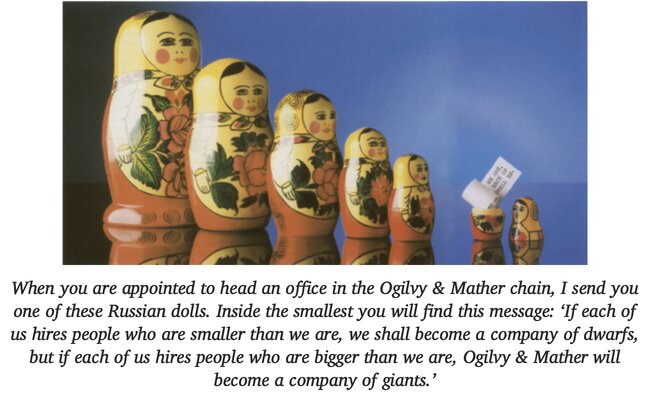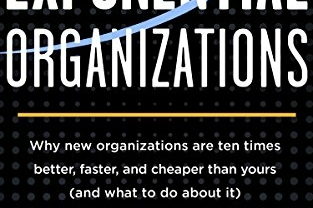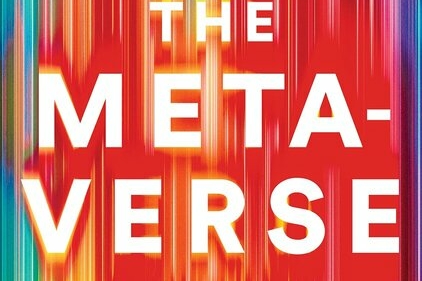“When I write an advertisement, I don’t want you to tell me that you find it ‘creative.’ I want you to find it so interesting that you buy the product.”In Ogilvy on Advertising, British advertising executive and founder of Ogilvy & Mather, shared insights gained from his over three decades of being an ad man. He dissects some of his most successful advertisements, such as the Avis, Beetle, and Mercedes Benz ads, to name but a few. He also shared some advertising copy that did not work, such as his first advert about a cooking stove with a naked woman. Ogilvy writes about what makes a great advert, writing a great copy, running a successful ad agency, dealing with clients, hiring great talent, researching campaigns and creating adverts that sell products. Favourite Takeaways – Ogilvy on Advertising I do not regard advertising as entertainment or an art form, but as a medium of information. When I write an advertisement, I don’t want you to tell me that you find it ‘creative.’ I want you to find it so interesting that you buy the product.
“When Aeschines spoke, they said, ‘How well he speaks.’ But when Demosthenes spoke, they said, ‘Let us march against Philip.”
- Consumers still buy products whose advertising promises them value for money, beauty, nutrition, relief from suffering, social status and so on. All over the world.
- You don’t stand a tinker’s chance of producing successful advertising unless you start by doing your homework.
- First, study the product you are going to advertise. The more you know about it, the more likely you are to come up with a big idea for selling it.
- Your next chore is to find out what kind of advertising your competitors have been doing for similar products, and with what success. This will give you your bearings.
- Now comes research among consumers. Find out how they think about your kind of product, what language they use when they discuss the subject, what attributes are important to them, and what promise would be most likely to make them buy your brand.
Sometimes, the best idea of all is to show the product – with utter simplicity. This takes courage, because you will be accused of not being ‘creative.Repeat your winners If you are lucky enough to write a good advertisement, repeat it until it stops selling. Scores of good advertisements have been discarded before they lost their potency. Research shows that the readership of an advertisement does not decline when it is run several times in the same magazine. Readership remains at the same level throughout at least four repetitions.
A good advertisement can be thought of as a radar sweep, constantly hunting new prospects as they come into the market. Get a good radar, and keep it sweeping.Château de Touffou If more copywriters were ambitious, they too would find fame and fortune. This is Touffou, the medieval castle where the author holes up when he is not visiting one of the Ogilvy & Mather offices.

Advertising reflects the mores of society, but does not influence them.Avoid small issue
- In your day-to-day dealings with clients and colleagues, fight for the kings, queens and bishops, but throw away the pawns. A habit of graceful surrender on trivial issues will make you difficult to resist when you stand and fight on a major issue.
- Don’t discuss your clients’ business in public places. Keep their secrets under lock and key. A reputation for leaking can ruin you.
Every time I give someone a title, I make a hundred people angry and one person ungrateful. – Louis XIVOn Hiring Success in running an agency depends on your ability to hire men and women of exceptional talent, to train them thoroughly, and to make the most of their talents. The most difficult people to find are those who have the capacity to become good copywriters.
 Gentlemen with Brains
I have always tried to hire what J.P. Morgan called ‘gentlemen with brains.’ It doesn’t necessarily mean a high IQ. It means curiosity, common sense, wisdom, imagination and literacy. Why literacy? Because most communication between agencies and clients is in writing. I don’t suggest that you have to be a poet, but you won’t climb the ladder very high unless you can write lucid memoranda.
Crown Princes – Royal Dutch Shell
Spot the comers on your staff, and plan their careers. Royal Dutch Shell has found that the most reliable criteria for selecting what they call Crown Princes are these:
1 The power of analysis.
2 Imagination.
3 A sense of reality.
4 The ‘helicopter quality’- the ability to look at facts and problems from an overall viewpoint.
On Focus – Elimination of non-essentials
Agencies add new services the way universities add new courses. Nothing wrong with that if you also discontinue services which have outlived their relevance. To keep your boat moving through the water, keep scraping the barnacles off its bottom.
Gentlemen with Brains
I have always tried to hire what J.P. Morgan called ‘gentlemen with brains.’ It doesn’t necessarily mean a high IQ. It means curiosity, common sense, wisdom, imagination and literacy. Why literacy? Because most communication between agencies and clients is in writing. I don’t suggest that you have to be a poet, but you won’t climb the ladder very high unless you can write lucid memoranda.
Crown Princes – Royal Dutch Shell
Spot the comers on your staff, and plan their careers. Royal Dutch Shell has found that the most reliable criteria for selecting what they call Crown Princes are these:
1 The power of analysis.
2 Imagination.
3 A sense of reality.
4 The ‘helicopter quality’- the ability to look at facts and problems from an overall viewpoint.
On Focus – Elimination of non-essentials
Agencies add new services the way universities add new courses. Nothing wrong with that if you also discontinue services which have outlived their relevance. To keep your boat moving through the water, keep scraping the barnacles off its bottom.
The easiest way to get new clients is to do good advertising.Headlines
- On the average, five times as many people read the headlines as reading the body copy. It follows that unless your headline sells your product, you have wasted 90 percent of your money.
- Headlines which contain news are sure-fire. The news can be the announcement of a new product, an improvement in an old product, or a new way to use an old product.
- When you put your headline in quotes, you increase recall by an average of 28 percent.
Until you’ve got a better answer, you copy.I copied Bob Gage for 5 years, I even copied the leading between his lines of type. And Bob originally copied Paul Rand, and Rand first copied a German typographer named Tschichold.’ I, too, started by copying. Working in a London agency, I used to copy the best American ads. Later, I began to do my own thing. Copy Format Readers look first at the illustration, then at the headline, then at the copy. So put these elements in that order – illustration at the top, headline under the illustration, copy under the headline. This follows the normal order of scanning, which is from top to bottom. If you put the headline above the illustration, you are asking people to scan in an order which does not fit their habit. On the average, headlines below the illustration are read by 10 per cent more people than headlines above the illustration. You may not think the difference worth writing about, but consider the fact that 10 per cent of, say, 20,000,000 readers is two million. Not to be sneezed at. Yet in 59 per cent of magazine advertisements the headlines are above.
Only 15 per cent of passengers carry anything to read. The other 85 per cent have nothing to do but read your copy.Visual Burr The average American family has the television turned on for six hours a day, and is exposed to 30,000 commercials a year. Most of them slide off the memory like water off a duck’s back. For this reason you should give your commercials a touch of singularity, a visual burr that will stick in the viewer’s mind. One such burr was the herd of bulls thundering towards the camera, with the superimposed title: ‘Merrill Lynch is bullish on America.
In the average American home, the TV is turned on, if not watched, for five hours a day, which adds up to 25 years in the average life.Always be Advertising “I have come to regard advertising as part of the product, to be treated as a production cost, not a selling cost. It follows that it should not be cut back when times are hard, any more than you would stint any other essential ingredient in your product.” Advertising is still the cheapest form of selling. It would cost you $25,000 to have salesmen call on a thousand homes. A television commercial can do it for $4.69. If you spend $10,000,000 a year on advertising, you can now (1983) reach 66 per cent of the population twice a month. Suggested Readings
- SCIENTIFIC ADVERTISING by Claude Hopkins. Introduction by David Ogilvy. Bell Publishing, NY.
- TESTED ADVERTISING METHODS by John Caples. Foreword by David Ogilvy. Prentice-Hall (Canada) 1975.
- REALITY IN ADVERTISING by Rosser Reeves. Alfred Knopf, NY 1961.
- MADISON AVENUE by Martin Mayer. Harper & Row, NY 1958.
- CONFESSIONS OF AN ADVERTISING MAN by David Ogilvy. Atheneum, NY 1962.
- NEW ADVERTISING: TWENTY-ONE SUCCESSFUL CAMPAIGNS FROM AVIS TO VOLKSWAGEN by Robert Glatzer. Citadel Press, NJ 1970.
- THE 100 GREATEST ADVERTISEMENTS by Julian Watkins. Dover Publications, NY.
- THE ART OF WRITING ADVERTISING by Denis Higgins. Advertising Publications.
- HOW TO ADVERTISE by Kenneth Roman and Jane Maas. Foreword by David Ogilvy. St Martin’s Press, NY.
- ADVERTISING INSIDE OUT by Philip Kleinman. W H Allen, London 1977.
- SUCCESSFUL DIRECT MARKETING METHODS by Bob Stone, Crain Books, Chicago 1979.
- OR YOUR MONEY BACK by Alvin Eicoff. Crown, NY 1982.
- THE ART OF PLAIN TALK by Rudolph Flesch. Collier Macmillan, NY 1962.
- WRITING THAT WORKS by Kenneth Roman and Joel Raphaelson. Harper & Row, NY 1981.
- THE ELEMENTS OF STYLE by William Strunk and E B White. Collier Macmillan, NY 1979.
- THIRTY SECONDS by Michael Arlen. Farrar, Straus & Giroux, NY 1980.
- SPEECH CAN CHANGE YOUR LIFE by Dorothy Sarnoff. Doubleday, NY 1970.
- THE DUPING OF THE AMERICAN VOTER: DISHONESTY AND DECEPTION IN PRESIDENTIAL TELEVISION ADVERTISING by Robert Spero. Lippincott & Crowell, NY 1980.
- OBVIOUS ADAMS by Robert Updegraff. Updegraff Press, Louisville, Kentucky.”


